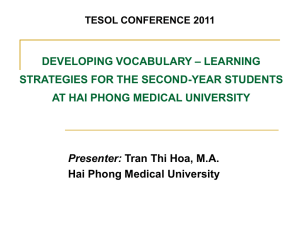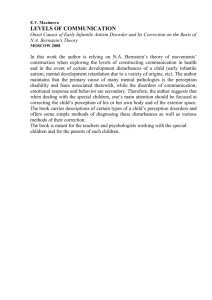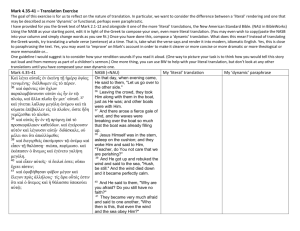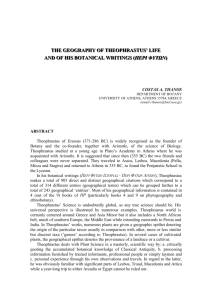Theophrastus-handout03
advertisement
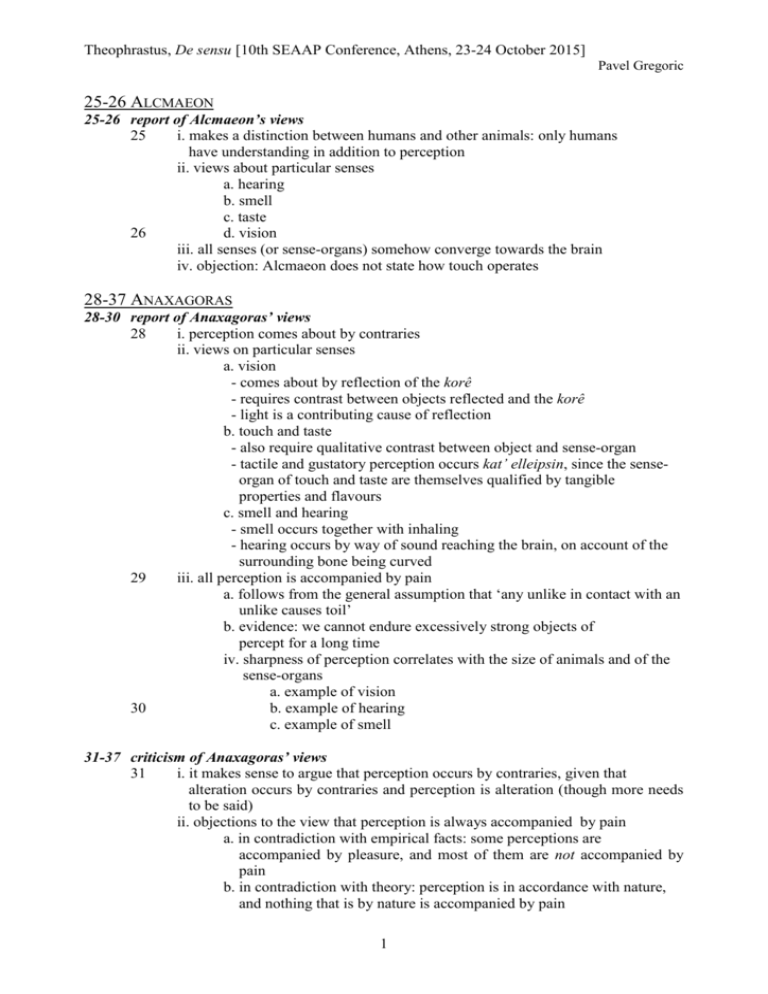
Theophrastus, De sensu [10th SEAAP Conference, Athens, 23-24 October 2015] Pavel Gregoric 25-26 ALCMAEON 25-26 report of Alcmaeon’s views 25 i. makes a distinction between humans and other animals: only humans have understanding in addition to perception ii. views about particular senses a. hearing b. smell c. taste 26 d. vision iii. all senses (or sense-organs) somehow converge towards the brain iv. objection: Alcmaeon does not state how touch operates 28-37 ANAXAGORAS 28-30 report of Anaxagoras’ views 28 i. perception comes about by contraries ii. views on particular senses a. vision - comes about by reflection of the korê - requires contrast between objects reflected and the korê - light is a contributing cause of reflection b. touch and taste - also require qualitative contrast between object and sense-organ - tactile and gustatory perception occurs kat’ elleipsin, since the senseorgan of touch and taste are themselves qualified by tangible properties and flavours c. smell and hearing - smell occurs together with inhaling - hearing occurs by way of sound reaching the brain, on account of the surrounding bone being curved 29 iii. all perception is accompanied by pain a. follows from the general assumption that ‘any unlike in contact with an unlike causes toil’ b. evidence: we cannot endure excessively strong objects of percept for a long time iv. sharpness of perception correlates with the size of animals and of the sense-organs a. example of vision 30 b. example of hearing c. example of smell 31-37 criticism of Anaxagoras’ views 31 i. it makes sense to argue that perception occurs by contraries, given that alteration occurs by contraries and perception is alteration (though more needs to be said) ii. objections to the view that perception is always accompanied by pain a. in contradiction with empirical facts: some perceptions are accompanied by pleasure, and most of them are not accompanied by pain b. in contradiction with theory: perception is in accordance with nature, and nothing that is by nature is accompanied by pain 1 Theophrastus, De sensu [10th SEAAP Conference, Athens, 23-24 October 2015] Pavel Gregoric 32 33 34 35 36 37 c. if thinking is not accompanied by pain, neither is perception – given that they both aim at cognition of things d. excessively strong objects of perception and the inability to stand them very long does not constitute evidence for the view that perception is always accompanied by pain e. this view amounts to an illicit generalization about a natural process from unnatural (non-standard) cases iii. objections to the view that perceptiveness correlates with the size of animals and of the sense-organs a. it seems that smaller animals are actually more perceptive, given that: i. sharpness of perception consists in discriminating small things ii. it is reasonable to suppose that an animal which can discriminate small things can also discriminate large ones iii. it seems that with regard to some senses small animals are actually more perceptive than large animals b. perceptiveness seems to have less to do with the size of the body and of the sense-organs, and more to do with the bodily disposition and mixture c. correlating the size of the objects and the sense organs is similar to Empedocles explaining perception in terms of effluences fitting the passages of the sense-organs d. it is inconsistent to claim that thin air is more odorous, yet that animals which inhale thick air have a sharper sense of smell than animals that inhale only thin air iv. objections to the reflection theory of vision a. the sizes of things seen and of the reflections do not correspond b. there can be no reflection of many contrary things at the same time c. some things are visible yet they do not produce reflection, e.g. motion, distance, size d. some animals have eyes such that no reflection can occur on them, e.g. animals with hard eyes and aquatics e. if reflection is the cause of visual perception, many inanimate things should see, e.g. surface of the water, polished bronze and many other reflective things f. more particular objections against claims developed in support of the reflection theory of vision i. if colours are reflected in one another, as A. claims, most of all intense colours in weaker ones, it follows that colours should see, especially black and other weak colours ii. we do not see light itself by any reflection iii. ‘black things are not deprived of light any more than the white things’ iv. we see reflections in other things too as they become more bright and pure v. given what he says about light, Anaxagoras seems to support the popular ancient theory that sight/eyes belong to fire because colours are especially connected with fire - he does introduce innovations in his account of the particular senses, and especially into his account of vision when he introduces the correlation of size and perceptiveness, though he fails to elucidate in detail the more corporeal senses. 2 Theophrastus, De sensu [10th SEAAP Conference, Athens, 23-24 October 2015] Pavel Gregoric PASSAGES (1) Theophrastus, De sensu 26, 507.1-3 DG ὁρᾶν δὲ τῷ στίλβοντι καὶ τῷ διαφανεῖ, ὅταν ἀντιφαίνῃ, καὶ ὅσῳ ἂν καθαρώτερον ᾖ, μᾶλλον. (2) Theophrastus, De sensu 27, 507.12-14 DG ἐμφαίνεσθαι δὲ μεθ' ἡμέραν, ὅτι τὸ φῶς συναίτιον τῆς ἐμφάσεως· τὴν δὲ χρόαν τὴν κρατοῦσαν μᾶλλον εἰς τὴν ἑτέραν ἐμφαίνεσθαι. (3) Theophrastus, De sensu 32, 508.14-17 DG ἔτι δ' ἐπεὶ καὶ ἡδονὴ καὶ λύπη γίνεται διὰ τῆς αἰσθήσεως, ἅπαν δὲ φύσει πρὸς τὸ βέλτιόν ἐστι, καθάπερ ἡ ἐπιστήμη, μᾶλλον ἂν εἴη μεθ' ἡδονῆς ἢ μετὰ λύπης. ἁπλῶς δ' εἴπερ μηδὲ τὸ διανοεῖσθαι μετὰ λύπης, οὐδὲ τὸ αἰσθάνεσθαι· τὸν αὐτὸν γὰρ ἔχει λόγον ἑκάτερον πρὸς τὴν αὐτὴν χρείαν. (4) Theophrastus, Metaphysics 8b10-14 ἡ γὰρ αἴσθησις καὶ τὰς διαφορὰς θεωρεῖ καὶ τὰς αἰτίας ζητεῖ· τάχα δ᾿ ἀληθέστερον εἰπεῖν ὡς ὑποβάλλει τῇ διανοίᾳ τὰ μὲν ἁπλῶς ζητοῦσα, τὰ δ᾿ ἀπορίαν ἐνεργαζομένη… (5) Theophrastus, De sensu 35, 509.6-8 DG εἰ δ' αὖ φαίνεται καὶ πολλὰ λανθάνειν τὰ μικρά [τῶν μειζόνων οἷον οἱ ψόφοι, χρώματα secl. Diels, Stratton], βελτίων ἡ τῶν μειζόνων· 3






